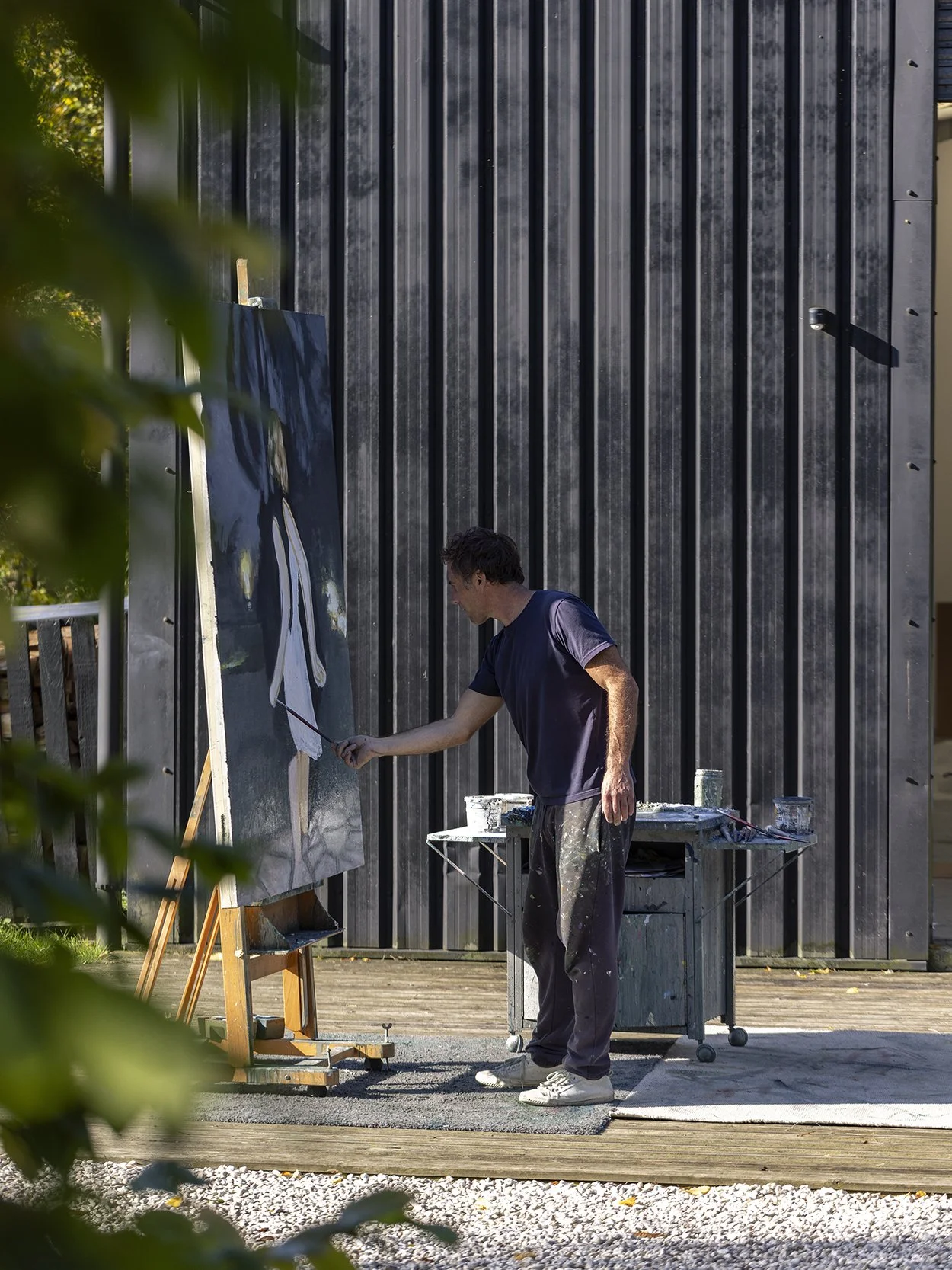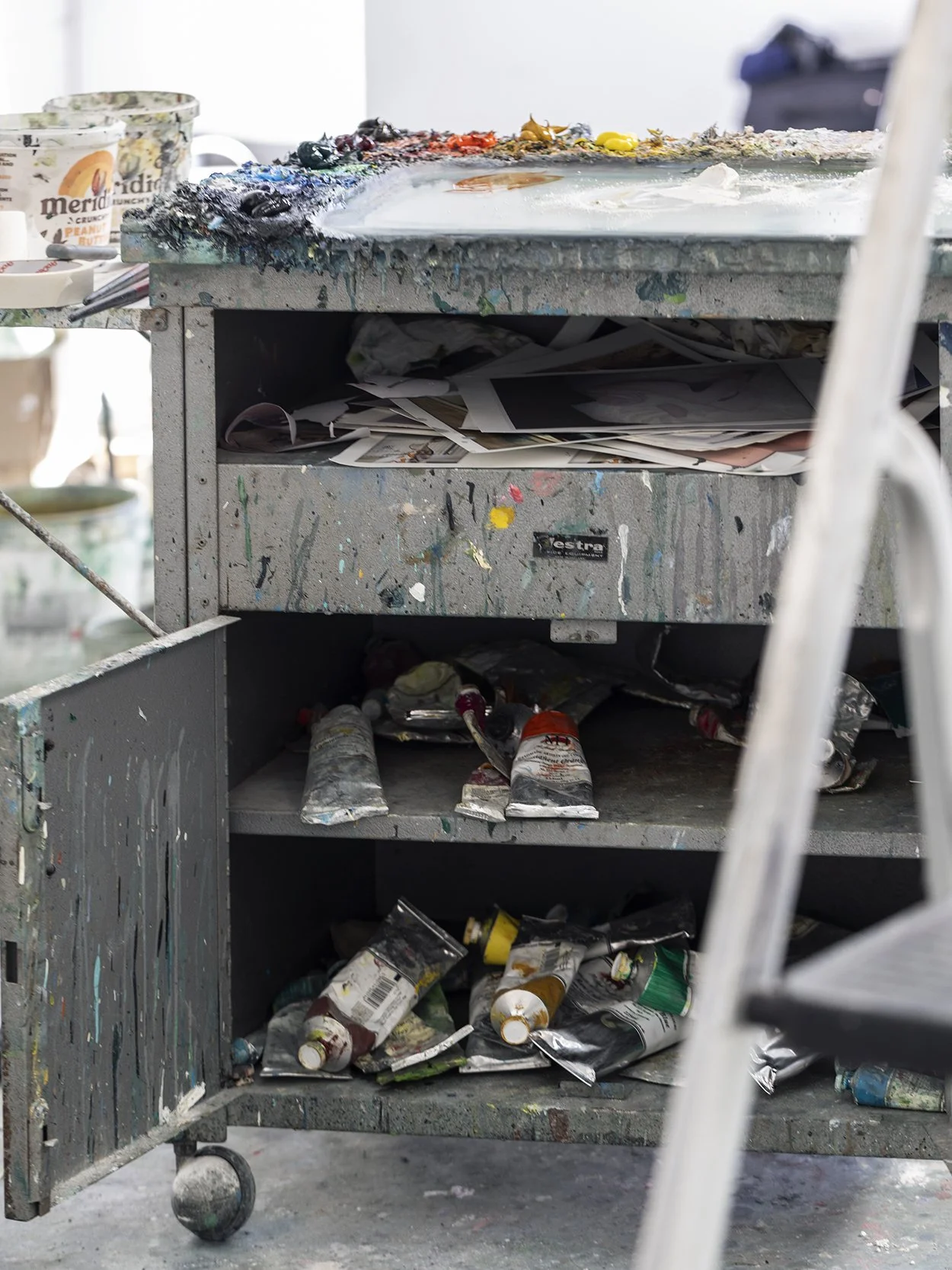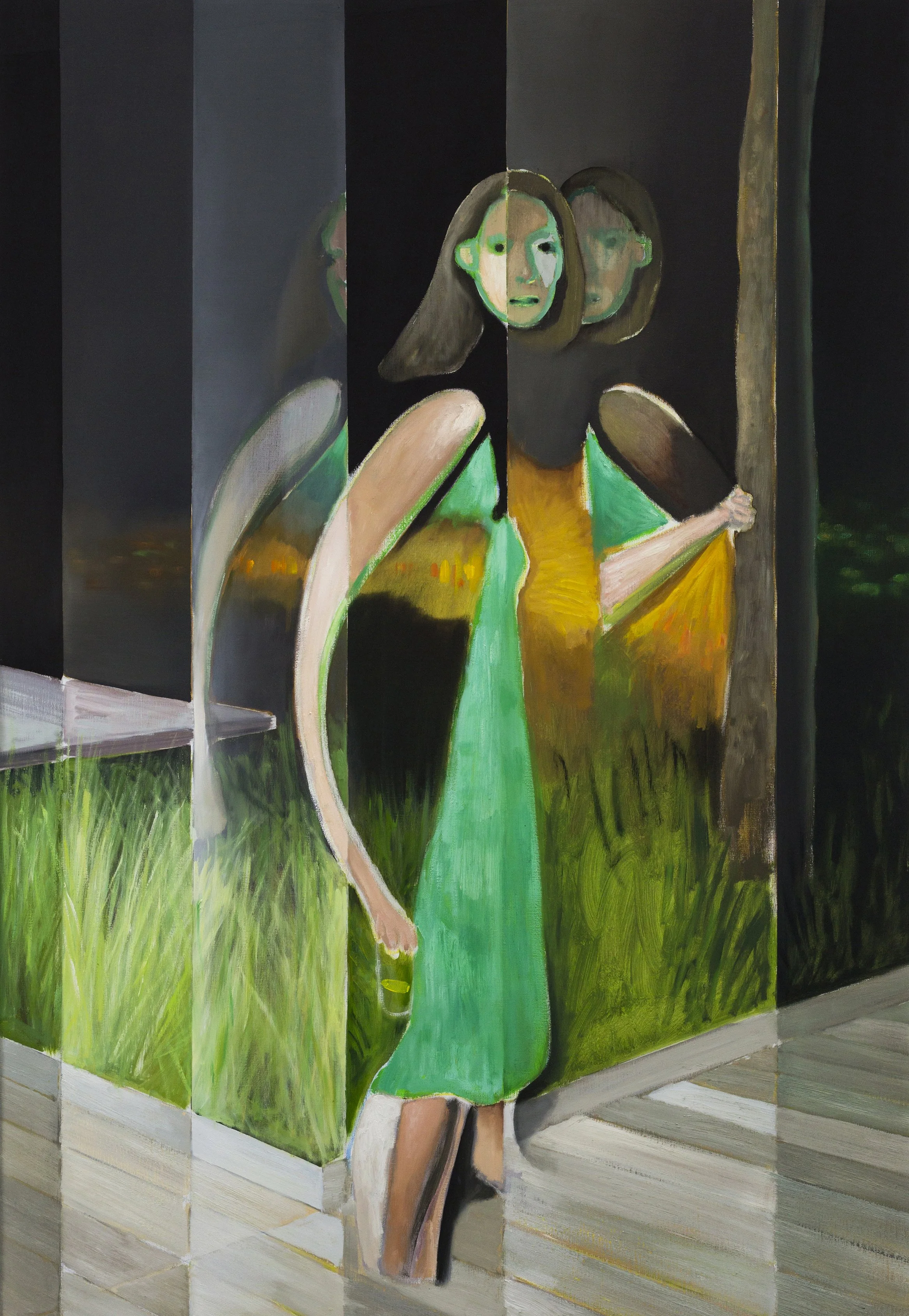Words Paul Tierney Photography Martin Crook
Published in No 20
There’s something reassuringly proper about the artist Jonathan Wateridge. With his discreet good looks and warm, well-spoken manner, he comes across as a man you could trust — solid, dependable, yet with an air of something vaguely naughty flickering behind the eyes which betrays this outward appearance. He’s remarkably easy to chew the cud with — about politics, art, and everything in between; intelligent without being pompous, and so unfailingly talented it seems almost unfair. So, on this solemn-looking afternoon, sky the color of lead, serious issues — life, love, art, death — are cogitated, with a wry smile never far away.
Today, in his seventeenth-century Norfolk farmhouse — two large out-buildings serving as studio space, and a family out of sight — he’s hunkered down in front of a wood-burning stove, the very image of a country squire. “It’s not London,” he admits, “but like a lot of people we moved here after COVID, and also because of the amount of traffic in the capital. London just turned into a kind of polluted swamp from about one in the afternoon, so the idea of fresh air made Norfolk appealing. I mean, it's a long way from metropolitan living, but I think I'm a fairly monastic person. I can happily squirrel myself away in in the studio for days on end.”
Those days have been well spent. At 52, Wateridge is a prolific artist with an international reputation of excellence. His style has moved in tandem with his life, but whatever canvas he cares to touch — from vast realist set pieces, to more ambivalent figurative gestures — the effect is never less than head-turning.
He is known for his distinctive approach to painting, often combining cinematic narrative techniques with traditional art forms. The work spans a range of media, but it is his large-scale oil paintings which have brought him the most attention. His art is marked by a focus on staged, often surreal scenes that reflect both the personal and collective experiences of contemporary life. The work grapples with themes of personal identity, transformation, and the passage of time. His paintings frequently depict figures in states of emotional flux, capturing moments of introspection, vulnerability, and change. It’s the fluid nature of human identity that interests him, the constant reshaping of the self.
“I was immediately smitten,” says his gallerist and dealer Nino Mier. “I normally find figurative painting repetitive and quite lacking. Jonathan could clearly paint a very hyper-realistic portrait if he wanted to, but I think he took a lot of painterly liberties and risks that were noticeable to me, a sense of mood that was just ... something different.”
Petrol Blue, 2019.
An upcoming show at Mier’s New York gallery reveals new works on paper. These might be prototype sketches or roughly blocked-out paintings, but the finished work — and they can take months to actually finish — are amalgam pieces, layered, sanded and added to for texture and depth. “Jonathan pushes and pushes,” says Mier, “he’s very rarely satisfied with his initial take on things. Work can be produced relatively quickly, but it’s the detail that comes later that really brings them to life — the tender touches and almost imperceptible add-ons. He takes his time, setting up a space within his own studio to resemble a gallery where he can hang the paintings. He’s hyper critical about his own work. It's rare to see someone take so much care.”
Having been born and raised under the African sun, Wateridge says, “I have to grab whatever meagre sunshine British skies can provide! It’s the best working light as well.”
The paintings delve into the concept of cultural identity. Drawing on his own experiences growing up in Zambia, his work — most prominently in his Pool series of 2015-2022 — reflect a nuanced understanding of cultural displacement and belonging. They are widely seen as explorations of the intersection between individual identity and collective memory, where personal histories are woven into larger narratives of migration, diaspora, and cultural exchange.
At 18 he left Africa for London, then made the move north to study at Glasgow School of Art. “I just assumed at that time I was going to make realist figurative paintings. Then of course as soon as I arrived at Glasgow, I just threw everything out the window and thought I needed to be making conceptual work instead. I’d started to become aware of all the YBA stuff but, at that point in time, Glasgow felt relatively traditional. This all changed when (Turner Prize winner) Douglas Gordon came along, but we didn't quite feel that yet in the painting department. I remember there being opposition to making non-painting-based work.”
Gust, 2019.
Lilo, 2018.
These were different times. Pre-internet, young artists had to rely on books, libraries and knowledge shared in smoky canteens and whiskey-fuelled pubs. “I think at that time, as a progressively minded young artist, I needed to be pushing boundaries. I'm always interested in sort of pushing things as far as I can, certainly within my own limits. But I wasn't aware of Richter or any of the stuff that was happening in other countries at the time. Kids today get so much information that they become over stimulated. I think it’s probably a double-edged sword. I feel whenever I meet younger artists now, they’re so much smarter than I was at that age.”
After a year following a meandering, conceptual trail, he gravitated towards film, (“although I didn’t know anything other than Andy Warhol”), pulled together funds to make his own, but admits it was complete disaster. “I thought, well what's the point in going back to Glasgow to paint when I just don't feel like I've got anything to contribute? So, effectively, I took a sabbatical at that point and just never went back.”
“There’s nothing more electrifying than walking into a gallery and being captivated by a work of art. You can’t beat that feeling, it’s incomparable.”
It's difficult to digest the idea that this talented young soul, clearly confused by direction, should spend the next fourteen years ‘on leave’ from his true vocation. “Painting just seemed moribund, so I stopped.”
It’s a little-known fact that for most of that time Wateridge adapted his artistic skills to the world of caricature “I used to do a weekly cartoon for the Times Literary Supplement. Whatever the book of the week was I would illustrate. I did stuff for The Sunday Times Magazine and the Economist. I even did the Spectator covers for about 10 years. It's not my politics but they paid double than anyone else.”
What followed was renaissance of sorts. Making his brother a small monoprint as a birthday gift was the catalyst that reignited his love of painting. Then a series of experiments led, inadvertently, to paintings that blended the figurative with work of a high level of detail. “I was always able to draw,” he muses, “and I've never had a technical painting lesson in my life. I mean, there are institutions where I'm sure you can go and learn those kinds of skills. But, in 1990s Glasgow, it's not like anyone was teaching you this.”
Somehow, realism became his thing. “To be honest, I'd hesitate to call my works at that time photo realism because they were they always quite painterly up close. They're definitely not a Chuck Close level of precision at all. But I thought, well if I'm interested in this idea of fiction and construction, I might as well pursue that.”
By building large scale sets, casting actors and creating imaginative tableaux, the work became ultimately cinematic. With this in mind, Wateridge is never more effusive than talking about the directors and films he admires — from David Lynch’s Mulholland Drive (”the atmosphere, the light!”) to the work of Michelangelo Antonioni.
”I think Fellini’s La Dolce Vita might be my favourite. It’s certainly the film that has just impressed me the most, and the more I go back to it the richer it becomes. Fellini’s virtuosity is incredible, and just like Antonioni, that mix of modernist minimalism, the kind of abstract framing, coupled with the action that's going on in terms of its mise en scène, is something that’s always really interested me. Having said that, I’d always take a painting over a film. There’s nothing more electrifying than walking into a gallery and being captivated by a work of art. It can happen with a movie, but it’s art that is more often likely to raise the hairs on the back of neck. You can’t beat that feeling, its incomparable.”
Deck, 2024.
Like all the best directors, Wateridge sets up questions for people, creating doubt and intrigue along the way. “Yes, it's asking questions, but it's also leaving things open-ended. I don't want to be prescriptive or didactic. I know my take on what it is, but that's not necessarily what everyone else should get from it. It's got to be open to other people's interpretation.”
In the last five years he has rejected realism for something more enigmatic. “I mean, I'd like I'd like to think that there's method in the madness, but there's obvious stepping stones that have taken me to where I am now.”
In his celebrated Pool paintings, figures pose and recline, rendered in a hazier, far less formal style than he is known for. There’s a spectral, disconnected atmosphere and a lighter outline to these ongoing characters which suggests fragility and impermanence. “I was looking at ancient Egyptian, Roman and Greek sculpture, the way statues become fractured and broken, and how sometimes that fragmentation, the slow erosion of features overtime gave them a sort of faded aspect. I quite like the idea of these figures being artefacts from the past but seeing them strangely in the present.”
It is this level of inspiration that sets him apart from many of his contemporaries. “I think there's a difference between inspiration and motivation. Bread and butter inspiration is most definitely seeing other artists and film makers. My guilty pleasure in life is art books. I just love a good heavy monograph. But motivation tends to be more, you know, the old stuff, where sex and death are never too far away. I think we live in an anxious age now where sex gives way to a general feeling of existential angst. That’s a compelling thing to capture.
There’s still a lot to explore. I'm 52, but I feel like I’m just starting out. I want to become braver and bolder. That’s what I find ultimately inspiring.”
Jonathan Wateridge solo show of works on paper is on view Sept. 5 - Oct. 18, ’25 at Nino Mier Gallery 380 Broadway, NY, NY.
Paul Tierney is an arts, culture and travel journalist, writing for W Magazine, The Guardian, El Pais and The Independent. paultierneywrites.com & @paultierneysees
Martin Crook is a regular contributor to UD martincrook.com











